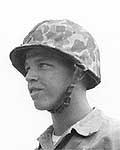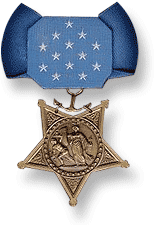Jack W. Kelso
| Jack William Kelso | |
|---|---|
  Jack W. Kelso, posthumous Medal of Honor recipient | |
| Born |
January 23, 1934 Madera, California |
| Died |
October 2, 1952 (aged 18) Killed in action in Korea |
| Place of burial | Washington Colony Cemetery, Fresno, California |
| Allegiance | United States of AmericaUnited States of America |
| Service/branch | United States Marine Corps |
| Years of service | 1951-1952 |
| Rank | Private First Class |
| Unit | 3rd Battalion, 7th Marines |
| Battles/wars | Korean War |
| Awards |
Medal of Honor Silver Star Medal Purple Heart Medal (2) Combat Action Ribbon |
Jack William Kelso (January 23, 1934–October 2, 1952) was a United States Marine who posthumously received the Medal of Honor for his actions on the night of October 2, 1952, during the Korean War. He was killed while covering the escape of fellow Marines from a besieged bunker. He was the 31st Marine to receive the United States's highest military decoration for valor during the Korean War.
Biography
Jack William Kelso was born on January 23, 1934 in Madera, California, and attended grade and high school in Caruthers, California. He worked on his father’s farm until he enlisted in the Marine Corps on May 15, 1951 at age 17.
- Marine Corps
Kelso completed his recruit training in San Diego, California, in July 1951 and that September was ordered from San Diego to Camp Pendleton, California. In January 1952, he left for Hawaii, where he served until April 1952.
- Korea
He embarked for Korea with Company I, 3rd Battalion, 7th Marines, 1st Marine Division as a rifleman. He earned the Silver Star Medal for gallantry in action on August 13 to 15, 1952. Kelso made some 20 trips through enemy mortar and artillery fire to carry ammunition from his company to another unit defending an important hill. Although the heat and enemy fire forced most of the men to be relieved after three trips, he continued to carry up ammunition and return with casualties until he collapsed and had to be evacuated.
- Medal of Honor
On the night of October 2, 1952, Kelso was serving at a vital outpost near Sokchon, Korea, when a numerically superior enemy attack, under cover of small arms, grenade and mortar fire, made casualties of both his platoon commander and platoon sergeant. After exposing himself to a hail of enemy fire to try to reorganize the unit, he was driven to cover with four other Marines in a nearby bunker, where an enemy grenade landed among them. He picked it up, ran into the open and threw it back at the enemy, receiving painful wounds as the grenade exploded on leaving his hand. He was again forced into the shelter by even more intense enemy fire, but refused to remain there. Moving out into the fire-swept area, he fired away at the enemy until he was mortally wounded, thereby covering the escape of the other Marines from the bunker. For his "conspicuous gallantry" in this final action, he was awarded the Medal of Honor. He was also posthumously awarded two Purple Heart Medals.
- Burial
His body was returned to the United States for burial. His remains are buried in Washington Colony Cemetery, Fresno, California.[1]
In popular culture
One of the protagonists in the video game L.A. Noire was named after Kelso (Jack Kelso) and shares a background in the Marine Corps.
Awards and decorations
Pfc Kelso's military awards include:
| Medal of Honor | Silver Star | Purple Heart with Gold Star |
| Combat Action Ribbon | Korean Service Medal with two bronze stars | United Nations Service Medal |
Medal of Honor
Pfc Kelso's Medal of Honor citation reads:
The President of the United States in the name of The Congress takes pride in presenting the MEDAL OF HONOR posthumously to
PRIVATE JACK W. KELSO
UNITED STATES MARINE CORPS
for service as set forth in the following
CITATION:
For conspicuous gallantry and intrepidity at the risk of his life above and beyond the call of duty while serving as a Rifleman of Company I, Third Battalion, Seventh Marines, First Marine Division (Reinforced), in action against enemy aggressor forces in Korea on 2 October 1952. When both the platoon commander and the platoon sergeant became casualties during the defense of a vital outpost against a numerically superior enemy force attacking at night under cover of intense mall-arms, grenade and mortar fire, Private KELSO bravely exposed himself to the hail of enemy fire in a determined effort to reorganize the unit and to repel the onrushing attackers. Forced to seek cover, along with four other Marines, in a near-by bunker which immediately came under attack, he unhesitatingly picked up an enemy grenade which landed in the shelter, rushed out into the open and hurled it back at the enemy. Although painfully wounded when the grenade exploded as it left his hand, and again forced to seek the protection of the bunker when the hostile fire became more intensified, Private Kelso refused to remain in his position of comparative safety and moved out into the fire-swept area to return the enemy fire, thereby permitting the pinned-down Marines in the bunker to escape. Mortally wounded while providing covering fire for his comrades, Private KELSO, by his valiant fighting spirit, aggressive determination and self-sacrificing efforts in behalf of others, served to inspire all who observed him. His heroic actions sustain and enhance the highest traditions of the United States Naval Service. He gallantly gave his life for his country.
See also
- List of Medal of Honor recipients
- List of Korean War Medal of Honor recipients
- Jack William Kelso at Find a Grave
References
- Inline
- ↑ "MOH Recipient Jack William Kelso". HomeOfHeroes.com. Retrieved 2006-06-18.
- General
 This article incorporates public domain material from websites or documents of the United States Marine Corps.
This article incorporates public domain material from websites or documents of the United States Marine Corps.
- "Private Jack William Kelso, USMC, (Deceased)', History Division, United States Marine Corps.". Retrieved 2016-08-24.
- "Pvt Jack W. Kelso, Medal of Honor, 1952, 3/7/5, Korea, Medal of Honor citation" (PDF). Retrieved 2016-08-24.
- "Medal of Honor recipients". United States Marine Corps Korean War Commemoration. Retrieved 2006-06-18..
- "Medal of Honor recipients: Kelso". United States of America Korean War Commemoration. U.S. Department of Defense. Retrieved 2006-06-18..